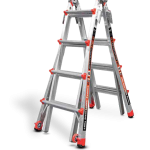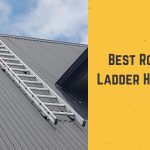People use extension ladders every day; to clean gutters, paint houses, or fix something on your roof. However, this helpful tool can also turn out to be dangerous. It has caused so many accidents leading to deaths. The stats below show how ladders can be dangerous and why you should take precautions when using them:
- The United States leads with the most number of ladder deaths. According to a report, the USA records up to 164,000 injuries resulting from ladder accidents. Even worse, at least 300 individuals lose their lives as a result of ladder accidents.
- The most ladder deaths result from people who fell from ten feet or less.
- The number of injuries and deaths has tripled in the last decades. That means that we could have more cases in the future if precautionary measures are not taken seriously.

The above stats prove that ladders can be dangerous, and as such, necessary precautionary measures must be taken.
In this post, I’m going to walk you through how to set up an extension ladder so that you can minimize some of these ladder accidents. Let’s dive in.
Table of Contents
How to Set Up An Extension Ladder
1. Get the Right Angle
You’ve probably, at one point, felt you’ll slip and fall when you’re halfway climbing your extension ladder. You feel like you ought to have secured your ladder from the base to maximize your safety whole up there.
However, we all make these mistakes as humans, and sometimes it’s not your fault. Maybe you don’t know how to set up an extension ladder, or you forgot to secure your ladder before climbing. This section will show you how you can set up your extension ladder at the right angle.
When setting up your extension ladder, make sure that the ladder leans 75 degrees from the ground. If you need to access a quite elevated place, erect your ladder and make sure that it extends three feet above your landing platform.

Don’t bend your ladder so much. If you can’t estimate the right angle (75 degrees), use the 4:1 ratio rule to help you find the right angle for your extension ladder.
2. Secure Your Feet
The next thing you need to do is secure your feet. Ensure that your feet can’t slip by flipping up your ladder shoes to poke into the ground. Additionally, it would help if you screwed the clear on the decks.

Next, you need to make sure that the bottom of your ladder is clean. Remove any objects that could cause your ladder to slip and fall. If there’s any sand around, clean it up before you set the ladder. If you still feel that the ladder could slip, tie your ladder legs with ropes to a solid object.
3. Secure the Top of Your Ladder
Securing the base of your ladder is just solving half of the problem. But it would also help if you did the other bit of securing the top of your ladder.
First, ensure that your ladder lies vertically against the wall you’re working on. Don’t tilt the top of your ladder either to the left or to the right. Instead, center it and let it lie on an even surface.
There are also a ton of accessories you can use to stabilize your extension ladder at the top. For example, you can use soft plastic mitts, which can be found in your local store or hardware. The advantage of soft plastic mitts is that they give a better grip to protect the ladder from slipping.

Another accessory you can opt for is rubber pads. These accessories provide an excellent grip to prevent the ladders from slipping sideways. You could also use ladder stabilizers to ensure that the top of your ladder is secure and doesn’t slide.
You can get all these accessories at any local store, hardware, or on Amazon. Prices may vary, depending on where you will purchase them. All the same, you need to research well and make sure that you’re getting the best ladder accessories. Ask friends, relatives, or read reviews and make a rational decision.
4. Tie the Top for More Security
Now, there are cases in which you’ll want to go up and down your ladder in the same spot; without changing the location. If this is the case, it makes a lot of sense that you tie the top of your ladder for more security.
Tying the top of your ladder will prevent it from slipping either to the left or right when moving up and down your ladder. Also, doing this will protect the edge of your shingles.

But there are more alternatives you can explore. You can set up your ladder on an adjoining wall or any other firm structure. Additionally, you can add more gutter straps where the top of your ladder rests if you always set up your ladder at the same point. Finally, it would help if you added eye screws above the gutter to give anchors for securing your ladder.
5. Get Your Level Base
You have probably secured the top of your ladder by tying it with ropes or installing eye screws to provide anchors. However, you would still need to ensure that your ladder base is on level ground to guarantee your security.
Now, putting bricks or any other object under one foot of your ladder isn’t a good idea. It could increase the chances of your ladder slipping. That said, avoid placing objects underneath the feet of your ladder.
Instead of putting objects under your ladder feet, create a shallow trench on the ladder foot where it appears raised to make it level on both sides. And because this is a reasonably light task, use your hammer’s claw to create a shallow trench.

If you don’t want to take a shot at digging the raised side of your ladder, get an adjustable leg-leveling extension to help find stability on both your ladder legs.
Bonus: How to Use The Ladder Properly
While this sounds like a no brainer, still, there are steps worth considering. First, you need to face the ladder without getting distracted. Using both hands, grab the ladder, and mount on it while facing it. Most importantly, maintain three points of contact while ensuring your center of gravity is within the side rails.
So to manage three points of contact, both your hands and feet should be on the ladder as you climb up to the next rung. Meanwhile, don’t carry anything while climbing the ladder as you can easily topple over. If you should carry any tools with you, please use a tool belt or tool vest.
Finally, ensure that the ladder is safely secured in place at all times – whether you’re climbing up or going down. Also, refrain from adjusting the ladder when somebody is on it to avoid unnecessary accidents.
Bottom Line
Let’s face it – mounting a ladder can be scary, especially when you have to clean the gutters, paint the ceilings, among other tasks. However, understanding how the ladder works before using it goes a long way to prevent accidents. You don’t have to be a victim.




